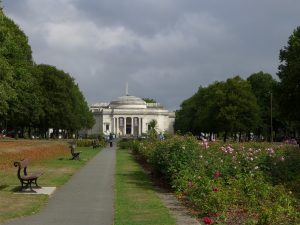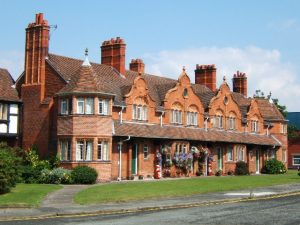
In 1887 William Hesketh Lever, a grocer’s son from Bolton, purchased a large parcel of swampy land in Birkenhead with the intention of building a soap factory. That factory was the start of what is now the global company Unilever. William Lever, later Lord Leverhulme, had a strong vision for business, but it is his vision for living that may have something to teach us about the designing and planning of housing. Alongside his factory William Lever built an entire community, over the decades that followed the draining of the tidal creek, 900 homes were built in Port Sunlight. But Lever’s vision was not just to build decent housing for workers of all ranks, but to create a cultural community that would nurture the workers.
With a strong belief in education he built two schools, teaching such subjects as French, art and music in addition to literacy and numeracy. For the fitness of his workers he built a swimming pool and gymnasium; for their health a hospital; for their entertainment, a theatre and two halls where diverse activities took place; for their social needs a public house, which was initially a temperance establishment but which, following a poll of workers, later sold alcohol; for their creativity, an arts and crafts centre where new skills could be learnt; for their spiritual needs a church; and, for their cultural appreciation, an art gallery containing his vast collection of art and artefacts. A train station was also built to serve the community and enable workers and visitors to travel to and from Liverpool and further afield.

Image:Rich Daley under Creative Commons Licence
The vision was bold and achieved using the best architects and craftspeople. The village was designed in Arts and Craft movement style by 32 architects, including Ernest Newton, and Edwin Lutyens, achieving a mix of styles with the homes of high ranking workers next to the lowly, achieving a social mix in each street. The concern and respect that the industrialist showed to his workforce is poignantly epitomised in the Port Sunlight war memorial, which was built following the tragic loss of 500 employees from the soap works who fought in WW1. The memorial is the second largest in the UK after the centotaph and the most magnificent, designed by sculptor William Goscombe John, to Lever’s specification, to depict not only heroism but loss.

Port Sunlight stands among many other ‘model villages’ built by industrialists to house their workforce. What marks it out though, apart from the diverse building styles, is the use of formal and informal open spaces creating the lungs of the village. A boulevard in the centre of the village provided vistas of the Lady Lever Art Gallery, whilst elsewhere the drained creek was turned into a sunken park. Around the site were allotments for families to grow their own food.
Whilst this is intrinsically interesting from a historical point of view, it seems to me that there are lessons to be learnt from the planning and design of this community. There is currently a push, in the UK, to build vast amounts of new housing and planning laws have been relaxed to achieve this which some fear could lead to a reduction in standards and very high density estates. There is thus no better time to consider how the success of communities such as Port Sunlight was achieved.
The homes built more than a century ago are still standing and still inhabited, which is testament to the benefits of building to high standards with high quality materials. However it is Lever’s holistic vision of community which is even more vital to the community’s success. Going beyond the simple provision of housing with an understanding of the social, psychological and cultural needs of the residents created a healthy and thriving society. The benefits of this were clear, a happy community was one in which people could realise their potential, it is also one that could be self-regulating, tackling problems before they escalated.
If we, in the 21st century, build housing without building communities and without really considering the holistic needs of residents, then we are missing an opportunity to create a healthy and functioning society. Furthermore, we may be setting up problems for the future if new housing increases people’s sense of isolation and alienation. Building communities rather than housing is not the cheapest option at the point of build, but, in the longer term it may be the least expensive for society if it leads to a healthy, functioning society.

Leave a Reply